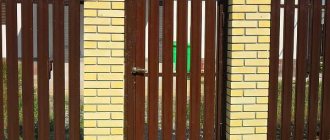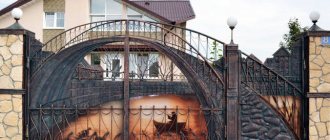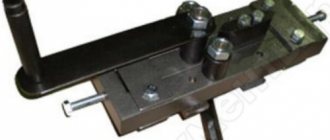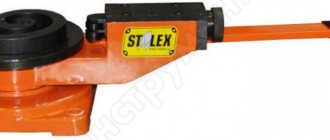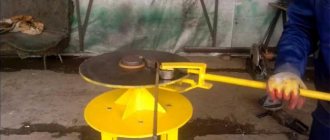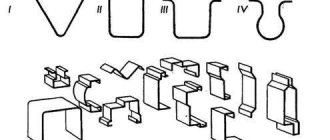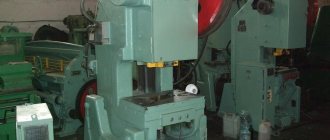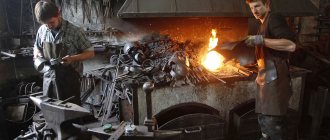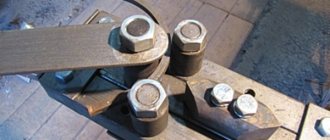Forged decoration of building facades, home and outdoor furniture, gates and fences made by the hands of a skilled blacksmith are an indicator of the status, presentability and taste of the owners. Laconic or intricate openwork patterns invariably attract admiring glances.
Imitation of forging involves bending metal and connecting it using welding.
Their only drawback is their high price. After all, real artistic forging is done by hand and often according to individual sketches. Imitation of forging can be a good replacement for those who want to decorate their home with metal products.
What is cold forging?
Real artistic forging involves processing metal heated to the required temperature. To perform it, you definitely need a separate room, a forge or forge and special tools.
To imitate it - cold forging, you only need a free room, for which even a garage or barn is quite suitable. Cold forging is quite accessible to those who want to make their own decorative grilles, fencing or some piece of furniture. Its essence lies in bending metal rods and then connecting them by welding.
Imitation of forging: Fence.
Products made using this technique are much stronger and more durable than cast or stamped ones. This is due to the fact that when using special equipment to give the required shape to a metal rod, simultaneous pressing and bending of the metal is performed. The additional pressure resulting from processing helps to increase the strength characteristics. True, if a mistake was made, it will be quite difficult to correct the damaged part.
The most technologically difficult stage of forging simulation is the assembly of the product. It is necessary to carry out welding work and thoroughly clean the seams, making them invisible.
Like any technology, cold forging has its disadvantages and advantages. The advantages include:
- simplicity of the manufacturing process, accessible even to inexperienced beginners;
- the use of machines for bending blanks allows you to reproduce with 100% accuracy the required number of products without any particular difficulties, for example, gratings for a fence.
The disadvantages of cold forging include:
- using standard machines, it is impossible to make a unique product;
- Having gone through forced deformation, the metal will still tend to return to its original shape, although this is a very slow process.
HAND FORGING FROM REAL FORGING MASTERS (Hot and cold forging of metal to order)
Forging of metals of any complexity with a quality guarantee for all supplied products
Since 1995, our blacksmith shop has been producing forged products of any complexity according to individual author’s sketches and our own design projects:
- gates with decorative forging
- fences and railings
- stairs, stair railings and railings
- fences
- door and window grilles
- forged and welded benches and garden benches
- chandeliers and lamps
- garden gazebos with forged elements
- pergolas, bridges and forged arches
- ritual metal fences, crosses and flower boxes
- forged canopies and canopies
- all options for forged home and garden furniture: chairs, tables, beds, hangers and any other decorative and artistic forging products.
In our production, in addition to ferrous metal and rolled metal, we use copper, brass and bronze - materials that convey certain images and moods. We will fulfill any of your orders for forged products with a quality guarantee. Call right now, write and come!
Our manufacturing company offers professional services for the creation of unique forged products and metal structures, designed according to our projects or according to your individual order. Having almost twenty years of experience in working with manual hot and cold forging of metal, we are professionally engaged in the complex production of forged and welded metal products and will undertake the implementation of the most complex design solutions in metal!
Manufacturing a full range of metal structures for home and garden
Our company has been operating in the retail and wholesale metal structures market since 1995. Our workshops professionally carry out custom-made any required forged decorative metal products and welded metal structures.
The blacksmiths and metalworkers of our company have extensive experience in the manufacture of forged and welded metal products.
A large number of specialists work in the production shops and workshops of our company: artists, designers, engineers, mechanics, blacksmiths, and each specialist is a true master in his field.
Our company's considerable production capabilities and experienced craftsmen using modern technologies and the richest Russian blacksmithing traditions allow us to produce forged and welded metal products both according to standard standard designs and according to individual customer sketches.
Our production company quickly and efficiently produces the widest range of forged and welded metal products to order: from hanging lanterns and lamps to forged gates with designer decor, as well as any other decorative metal products and design elements for a city apartment, country cottage, garden plot or park.
Our production company qualitatively produces to order a diverse range of forged and welded metal products from domestic manufacturers - from a forged coffee table and a decorative chandelier to a forged staircase with balusters and a garden decorative bridge with designer hand forging
Unlimited possibilities for decorative metal forging
Over the years of its existence, our company has produced to order, wholesale and retail, more than ten thousand items of forged metal structures and decorative forged products, as well as decorative and artistic design elements for interior decoration of country houses and apartments.
Among the completed orders there are a lot of forged products for the home with decorative forging - beds, decorative chandeliers, hangers, ottomans, decorative lamps, coffee tables and dining tables, chairs and armchairs, all products are made according to individual and standard drawings, in accordance with the client’s requests.
Cold forging equipment
In addition to a welding machine and the ability to handle it, home craftsmen who decide to try their hand at making forging with their own hands will need special machines.
Many craftsmen make them themselves, because their design is very simple. There are universal and highly targeted devices. The advantages of universal machines lie in a wide range of functions, but they will quickly become unusable due to active use or produce products of low quality. Therefore, it is preferable to have several machines for different operations.
A complete set of cold forging equipment consists of the following manual equipment:
Diagram of metal bending on a mandrel.
- a wave that allows you to obtain sinusoidal bends of the rod;
- snail - for making all kinds of spirals;
- twister - for twisting the workpiece along the axis;
- bendik - for bending a metal rod at the required angle;
- flashlight - for making special decorative elements;
- machine for producing rings.
The machines used in cold forging can be manual or electric. If this activity is a simple hobby, then manual equipment is sufficient. Workshops usually use electrical equipment that significantly increases productivity.
Forging tools and accessories
To manufacture forged products from profile pipes, it is necessary to use special tools and devices. You can make them yourself from scrap materials, order them from an experienced craftsman, or purchase factory models. You should also arrange a work area - a functional table, and provide space for forging long pipes.
To process small workpieces, you can use a tabletop with dimensions of 2000*1500 mm. It houses the main tools and devices for the production of products from profile pipes.
Gnutik
Designed for making arcs of various diameters. The machine consists of a T-shaped base on which support rollers are located in pairs. On the vertical stand there is a support roller, the height of which is adjusted using a threaded mechanism.
- Possibility of replacing rollers for bending pipes of various sections; Changing the distance between support elements to vary the radius; When making it yourself, it is recommended to use a U-shaped metal profile with a thickness of at least 2 mm.
The design of the bend for profile pipes differs from the traditional one. It is impossible to make a high-quality bend without evenly distributing the load over the entire surface. The average cost of a homemade model is 9,600 rubles.
Twister
Used for twisting profile pipes for artistic purposes. For processing, it is recommended to use models with a plowshare, which facilitates the manufacturing process, reduces the time of controlled deformation, and improves its quality.
The machine consists of a base on which a movable block for fixing the workpiece and a mechanism with a plowshare for twisting are mounted. Main equipment parameters:
- Maximum and minimum length of processed products. Section of the workpiece, its dimensions. They depend on the shape of the fastening mechanism; Drive type – manual or mechanical. To produce forged products from profile pipes at home, budget models with manual drive are most often used.
The price of a complete set is from 16,800 rubles.
Snail
It is used to make spiral-shaped components. The device consists of a square or rectangular platform. There are holes on it for installing supporting arc elements. A pipe end is used to secure the pipe. The bend is formed by the action of a lever mechanism with a support roller.
- maximum and minimum bend radius; workpiece size; permissible degree of mechanical impact.
The average cost of a household snail for bending profile pipes is 12,000 rubles.
The professional cutting machine "OS-7" is designed for cutting rolled ferrous metals of round and square sections, as well as round and profile pipes at an angle from 90 to 45 degrees. The machine is certified!
Energy consumption: 4 kW Productivity: 3 seconds per operation Payback: from 1 month Warranty: 3 years!
Cost: 78,100 rub.
Equipment for artistic metal forging is divided into several types:
— manual equipment (devices)
— electric machines without CNC
— electric CNC machines.
The most common type of forging machines today are electric non-CNC machines, this is due to the best price-performance ratio.
Forging equipment is widely used in such areas as:
- production of metal products - gates, fences, window grilles, etc.;
- ritual sphere - making fences;
— production of forged furniture;
— production of entrance doors.
Modern machines for artistic forging do not require heating the workpiece in a forge; now almost all operations on the machines are performed on cold metal, only some operations require heating; compact forges running on propane are supplied for this purpose. Even a person who does not have the knowledge of a blacksmith or engineer can operate a forging machine; the machine is controlled using either a joystick, buttons or a pedal.
Due to their compactness, forging machines can also operate in small rooms and workshops, and can be easily moved on a hydraulic trolley and transported on a Gazelle.
Performing cold forging
Cold forging has one feature - it is the ability to work with metal that is not too thick. Despite this, if you have the necessary tools, a self-made imitation will have a beautiful appearance. The work is carried out in several stages:
Types of welded joints.
- It all starts with a sketch. It is necessary to draw and mark all the details on it. When coming up with a pattern, you need to remember the capabilities of the machines that will be used, and not just follow your imagination. The sketch is also used during assembly of the finished product.
- Based on the sketch, the required amount of material, the thickness of the rods is determined, and the equipment is adjusted.
- Start making parts. Their shape and quantity depend entirely on the chosen design and available equipment. It depends only on the master whether he will use one or all six equipment in his work.
- After all the parts are ready, they proceed to assembling the product. When performing welding work, you need to be especially careful with small parts. For greater decorativeness, you can use ready-made flowers, leaves or endings, which simply need to be welded to the structure.
- Welding seams are carefully cleaned to make them as invisible as possible. This will make it possible to imitate artistic forging more efficiently. At home, this operation can be performed with a grinder or grinder with a special wheel.
- Painting completes the manufacturing process. Before applying paint, it is best to coat the product with a primer.
https://moyakovka.ru/youtu.be/uiLvzwYrCl0
Despite investing money in metal, tools and paints and varnishes, an imitation made independently will cost much less than real artistic forging. Handmade products will become a worthy decoration for your garden plot or part of the interior of your home.
Imitation of forging. Decorating the box.
Imagine a fine sunny day, you are walking around St. Petersburg... All around there are canals, gardens, cathedrals, ancient buildings for which the northern capital is so famous - an absolute aesthetic pleasure! But I want to talk about a specific place, or rather, even about what it is fenced with. I'm talking about the forged fence of the Mikhailovsky Garden. I believe the skill with which it is made and the unusual design, recognizable by its outline alone, has inspired many artists, and I am no exception. Of course, the further work presented has little to do with this work of art, it is more likely the result of my thoughts about imitation forging in general, rather than imitation of anything specific. In any case, I tried to find a method by which I can convey the feeling of the appearance of forged products. So let's get started.
To imitate forging in the decoration of the box we will need:
— synthetic brushes: medium-sized round (approximately No. 5-7) and large and medium flat brushes;
- cotton clothesline;
- box;
— black primer “Tair”;
— transparent gel (you can use contour gel);
— “Artistic decolor” Black, Silver-black and Silver;
— finishing varnish “Tair”.
Step 1. Prime the box.
I recommend a black primer because later we will be using black paint, which may allow the bottom layer to show through. Accordingly, when using white primer, you will have to apply more layers of paint, which will increase its consumption.
Step 2. Sketch.
We look at photographs, sketches and projects of various forged fences and get inspired. Now we need to draw the contours along which the rope will be attached in the future.
Why do we apply the design first, rather than black paint as we would normally do, to avoid unpainted areas?
Firstly, you will no longer be able to draw on the black decolor with a pencil, pen, chalk or any other graphic supplies. You will have to use paint, which is not very convenient if you are making up a design as you go (the paint is difficult to erase, you will have to paint over it).
Secondly, the adhesion of the gel to the soil is much stronger than to the paint.
Step 3. Applying gel.
After completing the drawing, we begin to apply the gel along the specified contours. Why did I choose the gel? Firstly, because it is dense, any elements can be implanted into it well, while it creates a voluminous base for these elements. Secondly, it definitely won’t eat through the soil, as some adhesives can do. Thirdly, I simply like working with it more, since it does not smell, and it also dries longer than glue, which makes it possible to correct errors if necessary.
At this stage, it is better to use contour gel, but if someone, like me, only has gel in a jar on hand, then you can use it. With contour gel everything is simple, we just squeeze it out in a strip along the given contours. With gel from a jar, the process becomes more complicated. We take the gel from the jar thickly onto a flat, medium-sized brush and spread it like a spoon onto the contour, while simultaneously pulling your hand with the brush along the line, then you will achieve the most comfortable contour.
Step 4. Rope.
Now we glue a clothesline onto the gel. To do this, cut off the required piece from the skein by eye. Next, pressing one end with a finger, we begin to form a pattern with the other hand.
Move along the rope in small sections, all the time holding and pressing the sections that have already been laid out on the pattern. I advise you to have sharp scissors so that you can easily trim the tip at the end of the line.
We “smear” the ends of the rope with gel so that they do not puff up. When creating volumetric elements, i.e. in several layers of rope, like in this case a flower, wait until the previous layer dries and hardens.
Step 5. Coloring.
After the entire composition has dried, paint the box black. This will give it a greater resemblance to metal. Pay special attention to the painting of volumetric elements. I advise you to use a medium-sized round brush for this, as it will be more convenient for it to paint the internal relief and at the same time it will hold a sufficient amount of paint needed to saturate the fibers of the rope.
Step 6: Dry brush.
After the black paint has dried, we drybrush over the entire box with “Decolor” Silver-black.
Next, we also go through especially convex places and corners with “Decolor” Silver.
Step 7. Fastening.
We coat it in several layers with finishing varnish; it will give the necessary gloss to our work and make it more durable.
To make such work look more vibrant, you can add multi-colored mosaics, dot painting, and gold elements to the composition. I wish you pleasant creativity!
Artist: Averinova Alexandra.
A set of cold-processed elements
Basic elements obtained by bending, twisting, and pulling metal using special machines:
- curls: snail, resembles a comma; chervonka, imitates a dollar sign; volute, similar to a steering wheel with ends concave to one side;
- peaks and paws are used to decorate the ends of metal rods, obtained by rolling;
- rings, the element is manufactured by winding a rod with a round or square cross-section onto a mandrel and then cutting it into rings;
- A torsion bar, a beautiful element, is obtained by twisting one or more square rods along an axis.
To make an element on a cold forging machine, the master uses levers. Thanks to a well-thought-out design, human effort increases significantly, is transferred to the metal and deforms in the desired direction.
Making a “forged” rose from paper
These roses can be useful for decoration, or you can simply use them yourself,
placing it in a vase or on a stand.
Let's spread some toilet paper on the work surface (if your surface is not plastic, then put multi-foam or oilcloth), about 50 cm, carefully coat it with glue and put another layer of paper on top (so 4-5 layers).
Let it dry slightly for 15-20 minutes (depending on the thickness of the glue and the amount of it on the paper), the paper should still be damp, but not stick to your hands.
While it dries, prepare the base of the flower. We wrap a cotton pad around a piece of wire, after lubricating it with glue on the inside, and form a drop-shaped shape. Bend the wire, skipping one revolution of the disk.
These are the blanks you should get. Lightly coat them with glue and begin forming the bud.
Cut about 5-6cm from the main layer, fold it in half crosswise and cut it into two parts. From these rectangles we will form a double petal with scissors. It should look like in the photo.
Now, having coated the edges with glue, we wrap our blanks with cotton pads. If you need a bud, then by connecting the edges of the petals at the top and pressing them a little, you can put it aside until the next stage. And for a fully open flower, we will cut out more petals.
We measure 3-4cm, cut it, fold it in half and cut it out. We crumple the top of the petal a little along the longitudinal axis and, after smearing it with glue, wrap it around the bud.
We cut out the remaining petals in the same way, only we don’t crumple them, but twist them onto a toothpick on top. There are also 2-4 such petals. And the remaining 2-4 pcs. twist from the sides.
Here you can already see which petals are twisted.
If the number of petals suits you, we proceed to the leaves, stem, and sepals.
To do this, cut 6-7 cm from the main layer and fold it in half. We cut the sheet diagonally, but so that the folded edge remains 2mm. See below.
Let's unfold the folded edge and make cuts like this, and in the middle there is a hole.
Let's put them on our flowers and buds, smear them with glue and press them. Let it dry.
While it sets, we make leaves. We cut them, like the sepals, bend them in the center and press them. Some I turn a little to the side.
Now we’ll cut a strip of 0.7-1 cm for the stem, coat it with glue and wrap it.
Now spread the lower part of the leaf with glue and wrap the leaf around the stem wrapped in paper.
Depending on the required length, you can repeat by wrapping the stem and gluing the leaf. Or you can connect three leaves together and then glue them to the stem. We send it to dry.
I dried it on the radiator.
I painted it with black spray paint. More convenient than using a brush. I took the newspaper and went out into the entrance (I laid it down and painted it).
Now we take bronze and a sponge and lightly smack it everywhere,
Let's admire it.
Hot Forging Equipment
If we compare the cold and hot forging methods, we can immediately say that the first method requires much more skill from the worker, the presence of some artistic skills and, of course, the ability to work with a set of necessary tools.
Forging of the material occurs after it is preheated in a forge furnace. It's called a forge. The forge is equipped with equipment for forced air supply. Heating is carried out to a given temperature and then transferred to the anvil. This is a metal plate on which impact processing of a heated workpiece is carried out. It is performed using hammers and sledgehammers of different weights. One worker, with a light hammer, strikes the desired place, and the second, armed with a heavy hammer or sledgehammer, strikes a strong blow to the designated place. After the workpiece has cooled, it is again loaded into the oven for heating. All movements of the part during its processing are performed using pliers with long handles.
Hand hot forging
In addition to the above-mentioned basic tools, during hot forging, many special tools are used that allow cutting hot metal and forming complex surfaces during hot forging of metal.
Forge
To heat the workpieces, furnaces are used, which are called forges. Its design includes several components. In particular:
- barrel made of fire-resistant material;
- hearth, with built-in grate;
- air supply and exhaust systems;
- working window through which long workpieces are fed;
- a chimney through which combustion products are removed.
Gas forge forge
In addition, the forge also includes a quenching bath. The operation of a classic forge is based on the unique reducing ability of carbon. It is this ability that successfully resists the oxidation of the workpiece, that is, its combustion. The calorific value of carbon is also important here. The fact is that when supplying air, it is necessary to regulate its quantity. There should be enough of it to burn the carbon, and the heat generated will raise the temperature in the furnace even higher.
In addition, the air supply to the forge must be adjusted so that the supplied oxygen is not enough to oxidize the metal. But if the heated workpiece is kept in this state for more than the required time, then it will become oversaturated with carbon. There is such a term - overdrying, that is, the metal becomes very fragile. By the way, cast iron can be used as an overdried metal.
Muffle furnace
Equipment that is used to heat parts made of different materials to a given temperature is called a muffle furnace.
A distinctive feature of this equipment is the presence of a muffle. So, they call a part that protects the part from contact with fuel and combustion products and at the same time serves as a chamber in which the part is heated. In practice, two types of such furnaces are used, with a permanent and replaceable muffle. In the first furnace, the loaded parts undergo all operations - from heating to readiness, in the second, only until cooling. That is, as the required temperature and a certain holding time of the workpiece are reached, one muffle is removed and another is installed in its place.
It should be noted that both the forge and muffle furnaces can use different types of fuel - gas, coal, firewood, light and dark oil products, etc.
Anvil
One of the key tools used for both cold and hot forging of metals is the anvil. It is on its surface that blacksmiths deform the workpiece and bring it to a finished form. The anvil is heavy and therefore it is rigidly fixed to a wooden block.
Anvil - Key Tools
The structural anvil consists of:
- horns;
- platband with holes;
- bases with paws for installing an anvil.
For the manufacture of this tool, 45L steel is used. It should be noted that anvils are products manufactured in accordance with a number of GOSTs. For example, GOST 11396-75 normalizes hornless products weighing from 92 to 200 kg, and GOST 11398-75 defines the requirements for products with two horns and weighing from 100 to 270 kg.
The hardness of the material from which anvils are made is 340 - 477 HB.
